|
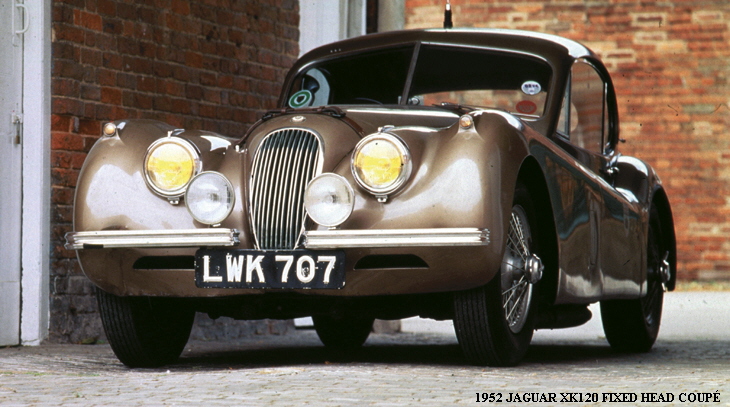
JAGUAR XK120
The XK120 took the world by storm when it was introduced in the 1948 London Motor Show. A particularly
enthusiastic XK120 owner and driver was Leslie Johnson, who drove one of the three works XK120s to victory in the Touring Car Race at Silverstone in 1949.
Using his own XK120, Johnson in 1950 decided to go in for endurance records. In October of that year, together with Stirling Moss as his co-driver, he did a 24 hour non-stop run at the Montlhéry race track near
Paris at an average of 107.46mph (173 km/h). In the following year, in the same car at the same venue, Johnson completed a one hour run at an average of 131.83mph (212 km/h).
Jaguar provided the car for Johnson's next venture. The car was only the second right-hand drive version of the new XK120 fixed head coupé, and the idea was to drive this for seven days and seven nights at an
average of over 100mph (161 km). Johnson's co-drivers in the attempt were Moss, Bert Hadley and Jack Fairman. The seven day run was made at Montlhéry, in early August 1952.
The first attempt had to be abandoned after the car hit a block of concrete, but after repairs the team started again. A spring broke on the fifth day, and although it was replaced and the run continued, no more
records could be officially accepted. Nevertheless, Jaguar's goal was achieved, as the car averaged 100.31mph (161.43 km/h) for the seven days and nights, having covered 16,851 miles (27,120km). In
addition, five new class records and four World Records were set for shorter distances, up to four days and 10,000 miles.
- Production 1948–1954 (12,055 made)
- Body style(s) [2-seat roadster (OTS)][2-seat coupé] [2-seat Drop Head Coupé]
- Engine(s) 3.4 L XK I6, FR layout
- Wheelbase 102 in (2591 mm)
- Length 173 in (4394 mm)
- Width 61.5 in (1562 mm)
- Height 52.5 in (1334 mm)
The "120" in its name referred to its 120 mph (193 km/h) top speed (faster with the windscreen removed), which made the XK120 the world's fastest standard production car at the time of its launch.
It was available in two 'open' versions, first as the roadster (designated OTS, for open two-seater, in America), then, also as a drophead coupé, DHC, from 1953 and as a closed, or "fixed-head" coupé (FHC) from
1951. The DHC was a more deluxe open model, featuring the beautiful wood dashboard and wood accent veneers on the interior as found on the FHC.
The first 242 cars, all roadsters hand-built between late 1948 and early 1950, had aluminium bodies on ash frames. To meet demand it was necessary for the mass-production versions, beginning with the 1950 model
year, to have pressed-steel bodies. They retained aluminium doors, bonnet, and boot lid.
With alloy cylinder head and twin side-draft SU carburetors, the dual overhead-cam 3.4 L straight-6 XK
engine was comparatively advanced for a mass-produced unit of the time. With standard 8:1 compression ratio it developed 160 bhp (119 kW). A 7:1 low compression version was also available to cope with low
quality fuel. This same basic design of the XK engine, later modified into 3.8L and 4.2L versions, survived into the late 1980s.
All XK120s had independent torsion bar front suspension, semi-elliptic leaf springs at the rear, recirculating-ball steering, telescopically adjustable steering column, and all-round drum brakes that were
prone to fade. Some cars were fitted with Alfin brake drums to help overcome this brake fade.
The roadster's lightweight canvas top and detachable sidescreens stowed out of sight behind the seats, and
its barchetta-style doors had no external handles; instead there was an interior pull-cord which was accessible through a flap in the sidescreens when the weather equipment was in place. The windscreen
could be removed for aeroscreens to be fitted.
The drophead coupé [DHC] offered a padded, lined canvas top, which folded onto the rear deck behind the
seats when retracted, and roll-up windows with opening quarter-lites. The flat glass two-piece windscreen was integral as a body-colored steel frame. Dashboards and door-caps in both the closed steel top coupe'
[fixed-head, FHC] and DHC were wood-veneered, whereas the spartan roadster's were leather-trimmed. All models had removable spats ("fender skirts" in America) covering the rear wheel arches, which enhanced the
streamlined look. On cars fitted with optional centre-lock wire wheels (available from 1951), the spats were omitted as they gave insufficient clearance for the two-eared Rudge-Whitworth chromed knockoff hubs.
In addition to wire wheels, upgrades on the Special Equipment, or SE, version (called the M version in the United States) included increased power, stiffer suspension and dual exhaust system.
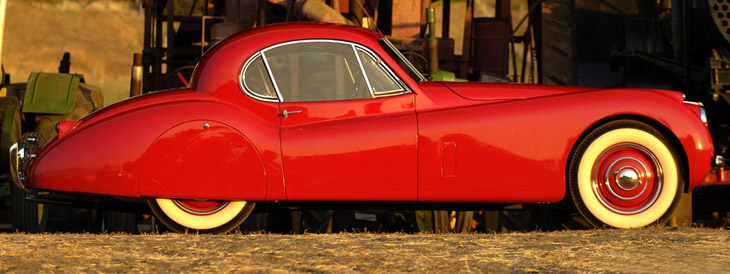
1952 Jaguar XK120 Fixed Head Coupe
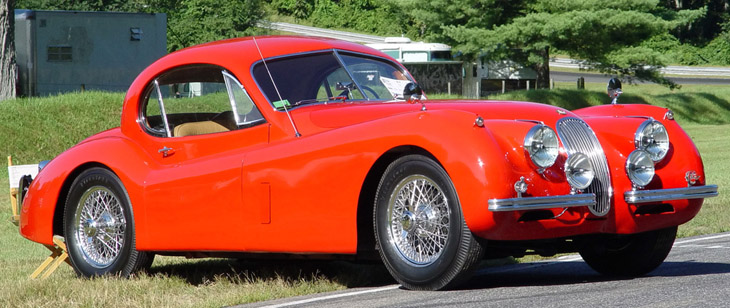
Jaguar XK120 Fixed Head Coupe
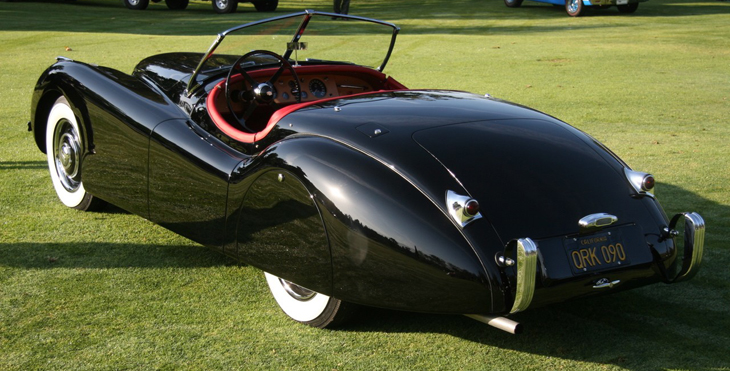
1950 Jaguar XK120
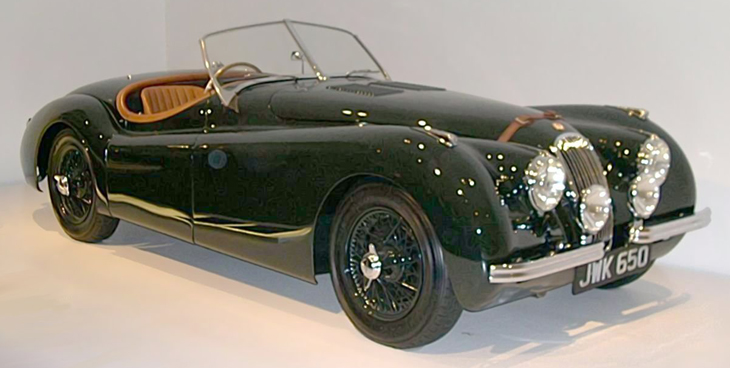
1950 Jaguar XK120 From the Ralph Lauren collection
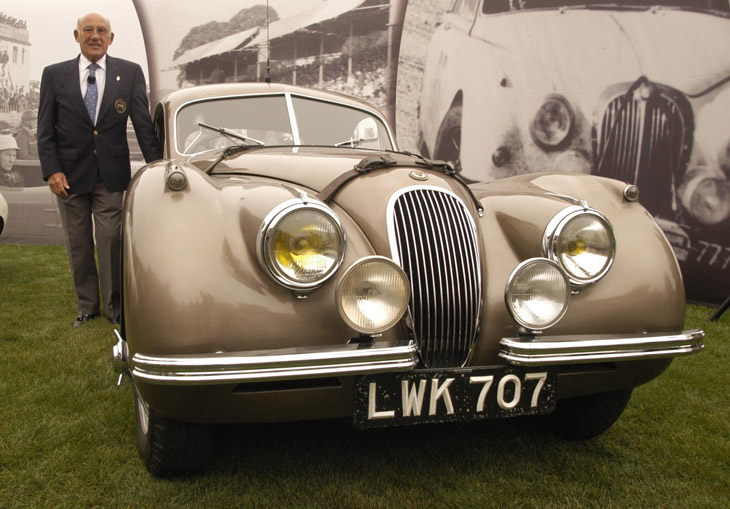
Stirling Moss with Jaguar XK120
20 June 2007 - Goodwood Festival of Speed
with an irreplaceable array of its most prestigious cars. With models from the 1950's to present day, the crowds will be left in no doubt that Jaguar remains an icon of British motor manufacturing.
Taking to the Goodwood hill climb will be the record breaking XK120 'Montlhéry' Fixed Head Coupé. Famous as the 'Seven Days and Seven Nights' car driven by Stirling Moss, Bert Hadley, Jack Fairman
and Leslie Johnson, the car averaged 100.31mph (161.43 km/h) for seven days and nights covering 16,851 miles. Joining the XK120 in the 'Classic Endurance Cars' group will be the 1956 long nose D-Type
which this year celebrates the 50th anniversary of an unparalleled 1-2-3-4-6 finish at Le Mans in 1957. Finally in the International Sports Cars category Jaguar will be entering the stunning and unique XJ13.
The Goodwood Festival of Speed is open from Friday 22nd June to Sunday 24th June 2007. All Jaguar cars will be on display and heading up the famous Goodwood hill climb.
|





